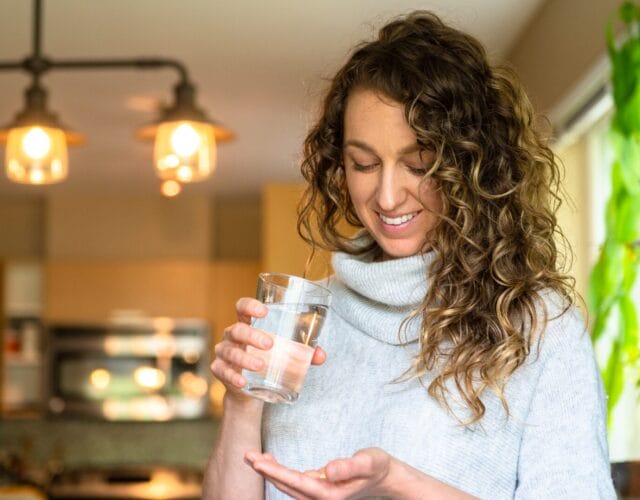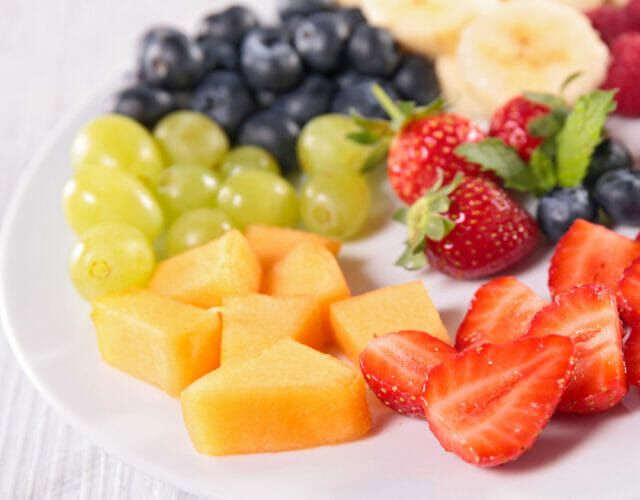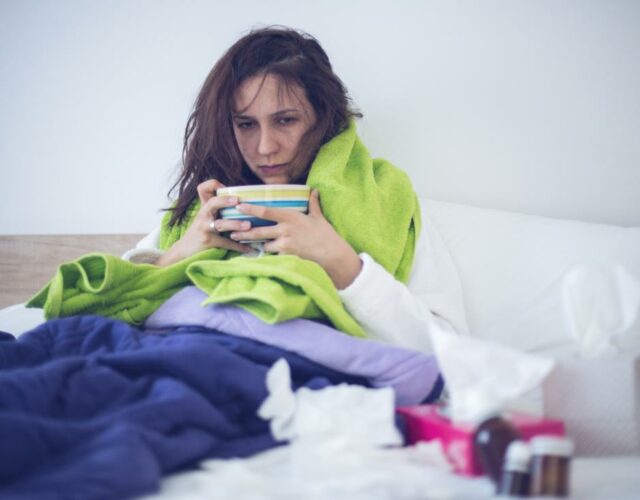If you’ve ever suffered from allergies, you know how frustrating they can be. But if your child suffers from allergies, it can be downright heartbreaking to see them so uncomfortable! In fact, my journey into functional medicine began with allergies in my children. I remember one year at Easter my youngest child couldn’t hunt for Easter eggs as his eyes swelled shut from allergies and his body was covered in hives. We had a constant flow of runny noses in my house. My colleague told me that we ran out of medication options and the only option remaining was to begin allergy shots—he was only 2 years old! I knew there must be a better way.
My hope is that all the parents out there don’t have to go through what we did with allergies. With so many over-the-counter medications coming with various adverse side effects, there are better options to deal with seasonal allergies.
Read on to learn more about children’s allergies and finally get a game plan for fighting back against pesky allergens in your home and community. We compiled a list of ten alternative allergy medications and some creative ideas to help you figure out where to start,
What Types of Allergies Affect Children?
When it comes to allergies for children, people are most often concerned about food allergies like peanuts or lactose. But seasonal allergies can be a major concern for many parents as the weather shifts and new life blooms all around our homes.
If you’re an adult who suffers from allergies, it can be easy to sympathize with your child. You can adjust playtime and activity to the season to avoid or reduce exposure to these allergens. But if you’re new to the world of seasonal allergies, what common allergens should you be aware of to prevent discomfort for your child?
- Pollen
- Dust mites
- Mold
- Pet dander
Understanding Seasonal Allergies

Seasonal allergies are often referred to as hay fever. The symptoms associated with seasonal allergies are most often prevalent when grasses, trees, and weeds release their pollen into the air.
Adults and children who are allergic to these pollens can experience a mild to severe reaction that negatively affects their day. When the body encounters the pollen, it releases a chemical called histamine into the bloodstream. The release of this chemical is what causes those uncomfortable allergy symptoms.
People can be allergic to several different types of pollen, and those affected may not be allergic to all the various causes.
Interesting fact – the pollen you see covering your car or outdoor furniture is typically too large to cause allergies in humans. But its presence is a great indicator that the smaller allergy causing pollens that we don’t see are in abundance.
Pollens are released during different seasons, so noting when the allergic reaction happens can help pinpoint which pollens are causing the most significant issues. East coast states experience high concentrations of:
- Tree pollens: February through June
- Grass pollens: May through August
- Weed pollens: July through November
It’s important to note that children may develop new allergies as their bodies develop. Seasonal allergies can start at any age but won’t generally develop until a child is at least two years of age.
Reduce Risk of Allergies Before They Begin
If you follow my blog or Instagram, you know that I believe reducing disease starts in the kitchen. Children who carry high levels of inflammation due to dysfunctioning immune systems are much more likely to develop seasonal allergies. Two-thirds of our immune systems reside in the gut—therefore if the gut is not healthy, the immune system suffers. Diets high in sugar and processed foods damage our gut lining and the beneficial bacteria that live there. The result is a problem termed “Leaky Gut” which leads to excessive inflammation.
Leaky gut is one of the reasons allergies, asthma, and eczema are so closely linked—if you develop one, you are more likely to develop all three. So consuming a diet rich in whole, organic foods is the first step to optimizing the immune system, lowering inflammation, and stopping seasonal allergies in the first place.
Symptoms of Allergies for Children
If you think your child may have allergies, there are several different signs you can look for in order to determine for sure. For example, if your child develops cold-like symptoms around the same time each year, they could have seasonal allergies. It’s important to note that each child is different, so it’s best to trust your parental instincts when determining care for allergies.
- Allergic rhinitis or hay fever
- Nasal congestion or a stuffy nose
- Ear infections
- Itchy nose and/or throat
- Blocked nose
- Sneezing
- Itchy, watery, or red eyes
- Runny nose with clear mucus
- Postnasal drip
- Sore throat
- Wheezing or shortness of breath
- Disturbed sleep or behavior changes
- Belly pain or reflux issues
- Headaches or mood issues
If you think your child may have allergies, it’s best to consult a physician who can review the symptoms your child is experiencing. Most physicians are able to diagnose seasonal allergies without testing, however in order to find the specific allergens causing your child’s symptoms, they can perform a skin or blood test.
What to Consider When Treating Allergies
Once you have cleaned up your kid’s diet and are on the path toward gut healing, reducing their exposure to the problem allergens will help. Depending on the allergy, you may want to avoid playtime during certain parts of the day. Ragweed counts usually peak in early midday, while grass pollen counts are higher in late afternoon and early evening. When they do play outside, it’s helpful to have them bathe and change clothes when they come inside to remove dust, dander, and pollen. Before planning outdoor activities, it can be helpful to consider what could make airborne allergens worse. Monitor your local weather and consider the following:
- Pollens thrive with cool nights and warm days
- Mold grows more quickly in areas of high heat and humidity
- Peak pollen levels are in the morning
- Rain will wash away pollen, but counts can soar afterward
- If there is no wind, most pollen and airborne allergens will fall to the ground
- If it’s warm and windy, pollen counts will be higher
At Home Daily Allergy Relief Tips

If you’re looking for natural allergy relief and holistic approaches for your kids, it can be challenging to determine where to start and how to create the proper regimen though I have written a book to help your child thrive.
In addition to utilizing alternative allergy medicine, there are many natural resources you can use to help reduce your child’s allergic response and help them find relief so they can be a kid again.
- Bathe and change clothing as soon as you come inside
- Keep your indoor air filters up to date and choose HEPA allergy rated filter
- Consider an air purifier, I love the AirDoctor(Click here for $300 Off)
- Keep your pets clean
- Vacuum and dust your home often
- During humid seasons, use a dehumidifier
- Apply hot and cold compresses when they’re feeling under the weather
- Eyedrops may help if your child’s eyes are itchy and red
10 Alternative Allergy Medicines for Kids
In addition to implementing some natural relief practices, there are some powerful alternative allergy medicines you can call in for additional support. When it comes to choosing medicine, it’s ideal to choose options that won’t result in unwanted side effects. These options can help your child find relief and maintain optimal health!
1. Immune Support
Quercetin Hist Defense and Quercetin Hist Defense Jr provide support naturally in order to support your child’s immune response during allergy season. Quercetin is a pigment extracted from plants that has been shown to regulate the immune system and support your child’s body.
2. Throat Spray
Using Biocidin throat spray can bring soothing relief to your child’s throat. Since the nasal and throat regions are the most affected by allergies, it’s vital to support healthy respiration.
Applying Biocidin directly to the throat provides immediate relief. In addition, it soothes irritation caused by allergies, dry weather, or excess use like singing.
3. Antioxidants
NAC, an antioxidant, helps replenish glutathione levels in your lungs and reduces inflammation in your bronchial tubes and lung tissue caused by pollen. In addition, you can also consider incorporating more antioxidant-rich foods into your child’s diet, like:
- Sweet potatoes
- Broccoli
- Spinach
- Carrots
- Avocados
- Pumpkins
- Grapes and raisins
- Artichokes
- Berries
4. Probiotics
Your child’s gut health plays a major role in not just how they can defend themselves against allergies but in how they process everyday illnesses. In addition, it plays a significant role in the immune system and their overall bodily health from birth onwards.
Introducing a probiotic can help enrich their gut bacteria by providing essential components that nourish the digestive system. Given high demand, if the DrAnaMaria probiotic is out of stock, a second option is offered from Microbiome labs.
5. Vitamin D
Vitamin D insufficiency has contributed to the rise of asthma and allergic disease. Nearly 60% of children worldwide have low vitamin D levels. Vitamin is an important modulator of the immune system and helps calm the inflammatory process. Get your kids out in the sunshine while using the tips in this blog to minimize pollen effects. Vitamin D supplementation is also a great way to get those vitamin D levels up.
6. Saline Nasal Rinse
If your child can do a saline nasal rinse, it can help rinse out any particulates in their nasal passages and clear up stubborn congestion. My go to nose spray is Xlear. I recommend doing the nose spray after coming in from playing outside and before bed for maximum benefit.
There are many different nasal rinse products or NetiPot type options, so you can try out a few different styles to see what works best for your child.
7. Local Honey
You can purchase and use local honey for children who are old enough, which will help their bodies regulate with your local pollen. If possible, consult local beekeepers for information about how the bees are kept, how the honey is collected, and the season it was produced. Understanding when your child’s allergies are the worst can help you choose the right product.My favorite honey is local, raw, unpasteurized, unfiltered.
8. Facial Steam
If your child is severely stuffed up, making them an herbal steam can help soothe irritated sinuses and help rid the nasal passages of excess or stagnant mucus. Boil several cups of water and add them to a large bowl with some herbs like eucalyptus, thyme, peppermint, and oregano.
Scale the number of herbs and the types used to your child’s age and avoid essential oils if possible since they are a concentrated form of the aromatic properties of the plant. Have your child hover their face over the bowl with a towel draped over their head to contain the steam and instruct them to breathe deeply for 5–10 minutes.
If your child is relatively young, do this with them to keep them occupied or sing them a few of their favorite songs to keep them engaged. It’s critical that you protect their delicate skin from the hot water.
If you prefer essential oils, place them in a diffuser. One of my favorite blends is Breathe by Doterra. Breathe also comes in a stick and for children aged 1-4 years-old you can apply the Breathe Stick to the bottom of feet and back. For kids over the age of four it can be applied to the chest as well. NEVER on the face.
9. Beneficial Herbs for Allergy Support
There are several helpful herbs you can utilize to support your child through allergy season. You can incorporate them in herbal tea blends if your child will drink them, add them to popsicles, smoothies, or sa. A few herbs you will likely be able to find are:
- Reishi
- Nettle
- Peppermint
- Mullein
- Plantain leaf
- Thyme
- Garlic
- Rosemary
- Turmeric
- Elderberry and Elderflower
Before using any herbs, it’s important to do your research to ensure they are safe to use for your child’s age and that there aren’t any contraindications that could put your child at risk. It’s best to consult your holistic pediatrician for guidance if you’re unsure.
10. Histamine Downgrade
A small amount of the population is deficient in DAO, the enzyme that breaks down histamine. Typically they have the AOC1 genetic polymorphism or SNP(single nucleotide polymorphisms). These are genetic changes in the enzyme that breaks down histamine. Histamine Block can help them process histamine-rich foods, especially if you can give the capsule before they eat to help them process the material and reduce any negative histamine responses.
For children who aren’t SNP, you can help them digest histamine-rich foods by taking a few simple steps when you go shopping. You can start by:
- Introducing more whole, organic foods
- Increasing fiber
- Adding healthy fats
- Keeping them hydrated
- Reducing their stress levels
- Eating more slowly and mindfully
- Chewing properly
- Getting more physical activity
When to Consult a Holistic Pediatrician
Taking a holistic approach to your child’s health is a wonderful way to help them learn more about their natural bodies, how their bodies respond to things, and find relief without harmful side effects. But not every holistic remedy will work for every child, so it’s essential to consult a physician if your child experiences any of the following:
- They spike a fever over 100 degrees
- Allergy symptoms last more than three months with holistic support
- They need additional support or relief
- Signs of a sinus infection or ear infection are present
- They can’t fall or stay asleep
- If they have any other health problems or take medication that could cause an adverse reaction with holistic care
- Their personality, energy levels, or behavior drastically changes
Where to Start
If you’re excited to learn more about taking a holistic approach to your child’s health and wellness, check out my holistic guide to childhood illness, which covers all you need to know about holistic health for children. You will better understand how a child’s body functions and learn new, creative, and alternative remedies to keep your child healthy.
To learn more about current trends in holistic health care, check out our blog. We regularly post articles with creative ideas to help you and your family live your best lives!




